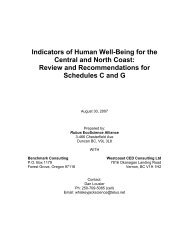Northern Plan Area Economic Opportunities and Barriers Study
Northern Plan Area Economic Opportunities and Barriers Study
Northern Plan Area Economic Opportunities and Barriers Study
Create successful ePaper yourself
Turn your PDF publications into a flip-book with our unique Google optimized e-Paper software.
Summary<br />
been non existent but recently the opportunity for extreme winter sports (snowboarding)<br />
in Tweedsmuir Park (Rainbow Range) have been tested with very good results using<br />
helicopter to transport clients. Snowmobiling in the area is world class but has not<br />
developed into a destination other than for local people <strong>and</strong> camperized traffic that stay<br />
on site. The ski hill is used by locals, as are the cross-country ski trails. Both have<br />
potential for increased use but locals are protective of the area <strong>and</strong> have tried to establish<br />
a code of ethic use.<br />
Eco-tourism as a new promotion idea is gaining some interest with both the sportsfishing<br />
lodges <strong>and</strong> the guide outfitters. The sports fishery <strong>and</strong> eco tourism if generated towards<br />
remote lodges leaves little revenue in the communities <strong>and</strong> employs few if any local<br />
residents. The exceptions are found at Shearwater, the lodge at Ocean Falls, Bella Coola<br />
valley <strong>and</strong> the Dean River where local goods <strong>and</strong> services are purchased <strong>and</strong> local people<br />
are employed.<br />
A recent study by the UN on eco tourism world wide noted that benefits to local<br />
workforce <strong>and</strong> revenue to communities shows an elitist track record of financial benefit<br />
only to the entrepreneur with few if any local employment opportunities or revenue flow.<br />
Eco tourism <strong>and</strong> recreational based fisheries directed from a local community base does<br />
indeed employ local resident <strong>and</strong> leaves benefits to local communities. This is not the<br />
norm for the Central Coast.<br />
The typical eco-tourist in today’s world is on average about 50 years old, they are<br />
interested in seeing new sights, being educated about historical <strong>and</strong> natural history <strong>and</strong><br />
the outdoors. They are looking for safe adventure, upscale accommodation, exceptional<br />
service, meals <strong>and</strong> entertainment. They enjoy all the amenities <strong>and</strong> have a preference for<br />
comfort. The traditional sports fisherman, which has been the typical tourist traveler falls<br />
into two categories: a) comes by air <strong>and</strong> leaves by air, spending one to two weeks at<br />
sports fishing camps <strong>and</strong> b) comes by camper, is self contained, independent <strong>and</strong> goes<br />
home when he has reached his catch limit. Occasionally this is a family affair <strong>and</strong> is<br />
frequently more common. Expenditures are in fresh food <strong>and</strong> gas for the trip home. The<br />
Discovery Coast ferry is bringing more non-traditional tourists who appear to be<br />
spending more time in the area. Tour busses are also appearing whose clients do spend<br />
time in local stores <strong>and</strong> at tourist attractions. Tour bus clients tend to be more senior <strong>and</strong><br />
not high activity oriented. The Discovery Coast Ferry route is expected to experience<br />
steady growth.<br />
Kayaking <strong>and</strong> marine boating in the area is increasing. Goods <strong>and</strong> services are purchased<br />
<strong>and</strong> gas for the boaters.<br />
A recent survey (1998) of tourist visitors to the Central Coast rated scenery the highest,<br />
food, accommodation second <strong>and</strong> the service industry moderate to low.<br />
Infrastructure within all Central Coast communities is significantly lacking. The low tax<br />
base <strong>and</strong> small number of residents (30%) paying taxes makes down town beautification<br />
<strong>and</strong> amenity development nearly impossible. Maintenance of tourist sites is always very<br />
5

















